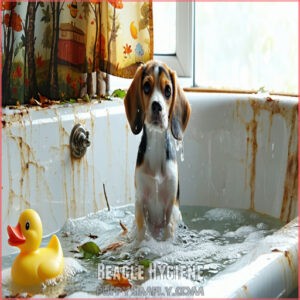This site is supported by our readers. We may earn a commission, at no cost to you, if you purchase through links.

They’re friendly, curious, and yes, a little stubborn—think of them as the class clowns of the dog world.
Their love of food (and knack for stealing it) keeps things interesting, but that same nose-for-trouble also makes training a bit of a patience game.
Short, fun sessions with treats and praise work best.
They’re loyal and playful, making every tail-wag worth it.
Keep them active with sniff-friendly activities, and build trust with routines and love.
Whether it’s their charm or quirks, there’s always more to discover about mini beagles—these pint-sized pups sure pack a punch!
Table Of Contents
- Key Takeaways
- Beagle Personality
- Beagle Training
- Beagle Hygiene
- Beagle Health
- Beagle Care
- Beagle History
- Beagle Temperament
- Frequently Asked Questions (FAQs)
- What is the Lifespan of a Mini Beagle?
- How Much Does a Mini Beagle Puppy Cost?
- Are Mini Beagles Good for Apartment Living?
- How Often Should You Bathe and Groom a Mini Beagle?
- What Kinds of Toys and Activities Do Mini Beagles Enjoy?
- Are miniature Beagles good pets?
- What is the lifespan of a mini Beagle?
- What are the health issues with pocket beagles?
- What are the disadvantages of a Beagle?
- What is the lifespan of a miniature Beagle?
- Conclusion
Key Takeaways
- Mini beagles are affectionate companions, playful, and loyal, but they need daily exercise and mental stimulation to manage their energy levels and prevent boredom.
- Training them requires patience and consistency, as they can be stubborn and opinionated, but positive reinforcement with treats and consistency works best.
- Grooming is simple but essential, with weekly brushing, monthly baths, regular nail trims, and ear care to manage shedding and prevent infections.
- They’re prone to health issues like hip dysplasia, hypothyroidism, and obesity, so regular vet visits, a balanced diet, and proper care are critical for their long-term well-being.
Beagle Personality
Mini beagles are tiny tornadoes of charm, curiosity, and chaos.
Their emotional depth and social skills make them masters of pack dynamics, thriving on connection and constant interaction.
For more details, see this beagle temperament overview.
The miniature beagle personality is bold, stubborn, and full of behavioral quirks.
They’re food thieves with detective-level noses and boundless curiosity traits, always exploring or testing limits.
Don’t be fooled by their size—this beagle temperament packs a big punch.
Love them, keep them busy, and they’ll reward you with endless loyalty and laughter.
Beagle Training
Training a mini beagle takes patience, but it’s totally worth it when you see their progress.
They’re independent thinkers with a bit of a stubborn streak, so using treats and praise will help keep them motivated.
Independent Thinkers
Training a free-thinking mini beagle feels like outsmarting a clever escape artist.
They embrace autonomous behavior and decision making with unmatched curiosity and resourcefulness. Finding effective mini beagle training treats is vital for success.
Here’s your game plan:
- Spark their problem-solving skills: Turn lessons into fun challenges.
- Short sessions, big results: Lasting 5-10 minutes.
- Fuel self-reliance: Celebrate their wins often.
- Treats work wonders, paired with clear commands.
- Consistency is key: No mixed signals.
- Carefully watch body language: Discover their “me first” temperament.
- Embrace patience unwaveringly solving missteps.
- Encourage independence, capitalizing on bursts of curiosity.
Relationship Building
Building a strong relationship with your mini Beagle is all about understanding their unique needs and forming a deep connection.
These little charmers thrive when you balance leadership with affection. You can find suitable mini beagle training treats online.
- Foster trust through consistent routines and calm communication.
- Strengthen social bonds by exploring new places together.
- Use positive reinforcement during training, focusing on what they do right.
- Dedicate playtime to meet their dog socialization needs and emotional support.
Relationship building isn’t always easy, but with patience and love, you’ll create a bond that lasts.
Motivation
In the context of beagle training, motivation is the name of the game.
Mini beagles thrive on reward-driven activities. Use positive reinforcement—think tasty treats, playful praise, or puzzle toys—to tap into their natural canine drive for fun and rewards.
High-quality beagle training treats can be purchased online.
Keep sessions short, upbeat, and packed with behavioral stimulation to match the mini beagle temperament. Celebrate every tiny win because this builds solid training motivation over time.
Make learning their favorite adventure, not a chore!
Stubbornness
Dealing with a mini beagle’s stubbornness? It’s like negotiating with a bossy toddler—cute, but determined!
Their independent beagle temperament makes training tricky, but it’s manageable with these tips:
- Be Patient: Stubbornness isn’t defiance—it’s learning at their pace.
- Positive Reinforcement Rocks: Clicker methods and reward systems work wonders.
- Consistency Training: Use identical cues every time.
- Make Learning Fun: Games and praise equal results.
- Set Clear Rules: Boundaries simplify behavior modification.
- Reward Curiosity: Encourage focus with treats.
- Adapt to Mood: Adjust for stubborn streaks.
- Avoid Punishment: Beagle training thrives on kindness.
Opinionated
Your mini beagle’s stubbornness isn’t just a quirk; it’s their way of showing off their strong opinions.
These little dogs have a knack for independence and a "my way or the highway" attitude that can leave you feeling like you’re negotiating with a furry philosopher.
Mini beagles—known for their mischievous and clever personalities—respond best when you understand their unique canine views.
Food is your ultimate bargaining chip, turning even the most opinionated moments into cooperative training sessions.
Use positive reinforcement to make their opinions feel heard.
Remember, their spirited personality reflects their intelligence and self-confidence.
Patience, humor, and consistency in mini beagle care will mold their attitude into a delightful partnership full of mutual respect.
Their care requires understanding that their strong will is a sign of their intelligence and self-confidence.
Barking
Beagles love being heard—it’s their thing.
But barking, whether it’s excitement, boredom, or their built-in alert system, can quickly test your patience.
Understanding their vocalization patterns and why they bark is step one.
Here’s how to manage these talented little howlers:
- Learn their barking types, like “I’m bored” barks or alert barking.
- Reward quiet moments with treats to lower noise levels.
- Use toys or puzzles to redirect energy (chew time beats shout time).
- Set boundaries, staying calm but consistent.
Barking isn’t bad—it’s communication. Finding balance keeps things friendly with neighbors and protects that lovable beagle personality.
Beagle Hygiene
Keeping your Mini Beagle clean might feel like a full-time job, especially when they love rolling in things they shouldn’t.
Regular baths, brushing, and a little patience will keep them smelling fresh and looking their best.
Coprophagy
Dealing with a mini beagle’s poop addiction isn’t fun, but it’s a common issue called coprophagia.
Feces eating happens for reasons like boredom, curiosity, or even health concerns.
Start by ruling out dog health issues with your vet.
Then, keep the yard spotless and distract your pup with toys or treats when they show fecal attraction.
Positive reinforcement works wonders, and if needed, deterrent sprays make stool consumption less tempting.
Remember, breaking this habit takes patience, consistency, and vigilance, and your beagle’s health and hygiene are worth it!
Yard Clean-ups
Nobody talks about the glamorous side of dog ownership: poop disposal.
Keeping your yard clean isn’t just about looks—it’s about beagle care and dog health issues too.
A messy lawn? That’s a shortcut to odors and unwanted pests.
Tackle yard cleanups like a pro:
- Grab a sturdy, long-handled pooper scooper to save your back.
- Go eco-friendly with biodegradable waste bags for poop disposal.
- Pick a spot in your yard for easy waste removal and storage.
- Gloves and boots? Non-negotiable for proper yard sanitizing.
- Stick to a daily lawn maintenance routine—no skipping!
With these tips, both your yard and your mini beagle stay fresh and happy.
Dead Animals
It’s pretty gross, but mini Beagles are often drawn to dead animals like moths to a flame.
Their strong noses make road kill irresistible, but the decomposition process can expose them to diseases.
Protecting your pup means staying alert during yard cleanups and walks.
- Remove carcasses immediately before curiosity kicks in.
- Distract with a toy or treat to break their focus.
- Start aversion training early to discourage the habit.
Keep an eye out, because this behavior ties into their instincts—not bad manners!
Feces
Dealing with poop isn’t glamorous, but it’s part of having a mini beagle.
Quick clean-ups are a must for hygiene and to avoid odors. Stay sharp with coprophagia training to keep your pup from munching on poop—it’s gross and risky.
Always monitor for any unusual consistency, as it could mean health issues. Equip yourself with poop bags and make waste management stress-free.
| Tool | Purpose | Why It’s Helpful |
|---|---|---|
| Poop Bags | Easy Waste Disposal | Keeps hands clean and yard tidy |
| Stool Analysis | Health Monitoring | Detects parasites or dog health problems |
| Deodorizer | Odor Control | Quick fixes for stubborn smells |
| Pooper Scooper | Feces Removal | Easy and back-friendly cleanup |
| Enzyme Spray | Hygiene Extra | Cleans and sanitizes accident spots |
Rolling in Unpleasant Substances
Ever caught your mini beagle turning stink attraction into an art form.
Rolling in unpleasant substances is part of their quirky charm (and your laundry headaches).
Here’s why this filth preference happens:
- Rolling Behavior with Purpose: It’s ancient instinct, like how wolves masked their scent from prey.
- Muck Delight: Weird smells excite them.
- Beagle Behavior 101: They wear scents to say, “This is mine,” spreading their unique aroma around.
- Dog Hygiene Nightmare: All this sensory exploring leaves you to manage the grooming aftermath.
Stay patient—it’s just part of beagle health!
Odors
Mini beagles have a knack for sniffing trouble—and sometimes carrying it.
Their unique body odor can come from scent marking, gas issues, or rolling in feces (coprophagia is real).
Tackling those odors means focusing on hygiene, stink removal, and some smell training.
Regular yard clean-ups and bathing are lifesavers, keeping unpleasant smells in check while letting your little hound stay lovable (and sniffable).
Bathing and Grooming
A muddy paw on your favorite rug? Your mini beagle’s double coat might need some TLC.
Grooming beagles isn’t complicated, but it takes consistency to manage shedding, odors, and general dog coat care. Beagles have low-maintenance grooming needs, so basic home grooming is usually sufficient.
Here’s a quick plan to keep them fresh and fabulous:
- Shedding Control: Beagles shed year-round, so brush weekly with a de-shedding tool. It keeps their coat conditioned and your sofa fur-free. Plus, it’s great bonding time!
- Nail Trimming & Ear Cleaning: Trim nails every 4-6 weeks. If you hear “tap-tap” on your floors, it’s time. For ear cleaning, check weekly for dirt or funky smells—they’re prone to infections.
- Baths & Skin Care: Bathe them every 4-6 weeks using gentle dog shampoo. Avoid overwashing—it dries their skin. Finish with a towel rub and treat because grooming should feel rewarding for you both!
Beagle Health
Taking care of your Mini Beagle’s health means knowing what to watch for, like common issues such as hypothyroidism or hip problems.
Regular vet visits, a good diet, and plenty of exercise can keep your little buddy happy and healthy for years, which is key to a long and healthy life with your Mini Beagle.
Orthopedic Problems
Beagle orthopedic problems like hip dysplasia, leg deformities, and spinal issues can sneak up on even the most energetic pups.
Miniature beagle health can be trickier since their compact size can stress joints, leading to bone fractures or intervertebral disc disease.
Intervertebral Disc Disease (IVDD) is a common spinal condition in Beagles.
Regular check-ups, joint-friendly exercise, and adding supplements keep your mini beagle moving happily—because floppy ears deserve a healthy, wagging tail!
Steroid Responsive Meningitis
While managing your pup’s bone health is vital, there’s another condition that needs your attention: Steroid Responsive Meningitis Arteritis (SRMA).
This inflammatory response affects young dogs between 6-18 months old, with miniature beagle health concerns topping the list of susceptible breeds.
Learn more about canine SRMA diagnosis.
Think your furry friend might be dealing with dog meningitis? Watch for these meningitis symptoms: neck pain (especially when looking up), fever spikes, and unusual lethargy.
You’ll notice your typically bouncy buddy isn’t quite themselves.
The good news? Steroid treatment works wonders when caught early.
Your vet will likely prescribe prednisone, starting at 4 mg per kg daily, with treatment lasting about six months.
While it might sound challenging, most pups bounce back beautifully with proper veterinary care.
Key tip: Don’t wait it out if you spot these signs.
Quick action means better outcomes, and your mini bestie deserves nothing less than exceptional care.
Irritable Bowel Syndrome
If your furry friend struggles with digestive issues, you’re not alone.
Dealing with Irritable Bowel Syndrome (IBS) means watching for telltale signs like diarrhea, bloating, and changes in bowel movements.
Your beagle’s gut health often takes hits from stress and diet shake-ups.
You’ll spot the signs: visible bloating, tummy discomfort, and maybe even some nausea.
When these pop up, it’s time for action.
Your vet can craft a game plan mixing meds to calm the gut, dietary tweaks, and stress-busting strategies.
The good news? With early detection and the right approach – from anti-spasmodics to special food choices – you can help your pup feel better.
Regular check-ups and a balanced diet keep that tail wagging.
Hypothyroidism
Here’s your 64-word content about hypothyroidism in mini beagles, incorporating the latest research:
Those tired eyes might be more than just puppy fatigue.
Hypothyroidism runs in beagle genes, but don’t worry – we’ve got solid solutions.
Consider a balanced canine diet for peak health.
Watch for these warning signs:
- Unexplained weight changes and unusual body condition
- Patchy fur and skin troubles
- Low energy levels, especially in older pups
Today’s thyroid medications work wonders, and with regular checkups, your mini beagle can live their best life.
Many dogs bounce right back to their playful selves with proper treatment, thanks to effective solutions and a balanced canine diet.
Seizures
Your miniature beagle’s health might include dealing with seizures, appearing as early as 3 months or as late as 9 years.
While epilepsy affects about 1 in 100 dogs, Beagles have shown increasingly complex cases over time.
Here’s what to watch for:
- Sudden blank staring episodes and excessive drooling
- Confused walking or unusual repetitive movements
- Unresponsiveness that seems out of character
- Stiff muscles or unexpected twitching
- Post-episode disorientation lasting several minutes
While one-third of dogs mightn’t respond well to medications , combinations of treatments, including phenobarbital and potassium bromide, often help control these episodes.
Remember, with proper care, most pups maintain their playful spirits.
Beagle Care
You’ll need to give your mini beagle plenty of TLC, from regular brushing to healthy meals and daily walks, to keep that tail wagging and those floppy ears perky.
While these pint-sized pups don’t need a lot of space, they’ll keep you on your toes with their grooming needs, vet checkups, and endless supply of energy that needs burning off.
Exercise
Your beagle’s boundless energy needs proper outlets to keep them bouncy and bright.
These natural hunters thrive on 60-90 minutes of daily movement.
Here’s your activity blueprint:
| Activity Type | Morning | Afternoon | Evening |
|---|---|---|---|
| Daily Walks | 30 min brisk walk | Optional play | 30 min walk |
| Play Time | Scent games | Puzzle toys | Garden zoomies |
| Running Exercise | Short sprints | Rest period | Fetch |
| Outdoor Games | Training fun | – | Hide-and-seek |
Remember, each beagle’s different – some might need more action, others less.
Mix up these activities to keep your pup’s tail wagging and mind sharp with proper outlets for their boundless energy, and ensure they get enough daily movement to stay healthy.
Diet
After burning energy with exercise, keeping your mini beagle well-fed takes some smart planning.
These food-motivated pups can charm their way into extra nibbles, so let’s get their diet right:
- Calculate portions carefully – your mini beagle needs about 45 calories per pound of body weight, split into morning and evening meals to keep their energy steady
- Balance their nutrition with 27% protein and 5.5% fat for adults, watching for signs of food allergies with limited-ingredient dog food
- Skip the table scraps – they might look cute begging, but human food can upset their tummy
Think of meal planning like training – stick to the schedule, and those puppy-dog eyes won’t derail your portion control efforts!
Grooming
Keeping your mini beagle looking sharp isn’t tough with the right routine.
Weekly brushing techniques, like using a slicker brush or undercoat rake, help with shedding control and keeping their coat healthy.
Nail trimming and ear cleaning are key, too—overgrown nails or neglected ears can cause issues.
Dog grooming is also bonding time, so make it enjoyable.
Dog grooming tip: High-quality tools aren’t just handy; they make coat care and beagle grooming a breeze.
Flea, Tick, and Worm Prevention
Pesky parasites can turn your beagle’s carefree adventures into constant scratching battles.
The good news? You’ve got this. Parasite prevention is all about staying ahead of the game. Consider exploring the best flea and tick pills available for thorough protection.
Here’s a simple, effective plan for Flea Control, Tick Removal, and Worm Medication:
- Give monthly parasite prevention treatments—your vet can recommend what’s best.
- Check your pup’s coat weekly for ticks, fleas, or signs of irritation.
- Stay on top of parasite life cycles to time treatments right—no surprises here!
- Ask your vet about seasonal Pest Management since risks can spike in summer.
- Add natural remedies, like sprays, alongside vet-approved solutions for safer, well-rounded care.
With a little effort, you’ll keep potential health problems from bugging your furry buddy!
Dental and Nail Care
Nobody loves a sloppy kiss from a dog with bad breath.
Good dog grooming tips, like regular tooth brushing and nail trimming, are game-changers for your mini beagle’s health.
Here’s your dog care checklist:
- Brush teeth daily to prevent gum disease.
- Try dental chews for easy dog dental care.
- Schedule vet cleanings every 1-2 years.
- Trim nails regularly to avoid discomfort.
- Watch for paw care signs, like nail clicking.
- Treat your pup to keep grooming fun!
Beagle History
Beagles have a rich history that goes way back to 14th-century England, where they were bred as skilled hunting companions.
Over time, their smaller variations, like Pocket Beagles, gained popularity for their charm and adaptability, eventually evolving into the Mini Beagles we’re familiar with today.
Origins
Mini beagles carry a fascinating breeding history rooted in their ancient origins.
Their story starts as far back as 5th century Greek civilizations, where early pack hounds impressed hunters with sharp noses.
By the 14th century, their hunting heritage blossomed in Essex, England, under Reverend Philip Honeywood, who’s credited with refining this genetic lineage.
These compact dogs, celebrated for tracking and baying, became prized across Europe.
When they hit American soil post-Civil War, mini beagles quickly went from clever hunters to adored family members.
Their history of beagles showcases a remarkable blend of utility and charm.
Recognition by The American Kennel Club
The American Kennel Club (AKC) has recognized beagles since 1885, dividing them into two sizes: under 13 inches and 13-15 inches.
This lets mini beagles or pocket beagles meet strict AKC standards for dog shows and breed registration.
Want some pedigree papers? Miniature beagle breeders can guarantee these lovable pups stay true to their official AKC-approved lineage.
Popularity as Companion Dogs
These mini beagles, also called pocket beagles, are perfect companion dogs, fitting seamlessly into any family dynamics.
Their small size and big hearts make them ideal for cuddles, backyard adventures, or just hanging out.
Known for their emotional support and charm, they’re one of the dog breeds for families that combine affection with fun.
- Unmatched loyalty: Always by your side.
- Playful personalities: Built for smiles.
- Household integration: Adapts to any setup.
Size Variations
Let’s talk mini beagle size—a perfect mix of charm and versatility.
These pups come in two pocket-friendly options:
- Under 13 inches tall: true “pocket beagles” with ideal proportions for tight spaces.
- 13 to 15 inches tall: still small but with a touch more sass and length.
Lightweight, with a healthy puppy weight, these miniature sizes adapt perfectly to both cozy homes and active lifestyles!
Physical Characteristics
Ever notice how a mini beagle’s look just grabs your attention?
With their sturdy body type, soft coat, and those big, soulful eyes, they’re hard to resist.
Their playful ear structure—long and floppy—gives them a curious, hound-like charm that’s impossible to miss.
| Feature | Description | Variations |
|---|---|---|
| Body Type | Muscular, compact | Sturdy frame |
| Coat Length | Short, dense | Tricolor or bicolor |
| Eye Color | Brown to hazel | Deep, expressive |
| Nose Shape | Rounded, dark | Classic hound style |
Mini beagle size is petite yet balanced.
Miniature beagle length and weight fit perfectly into an under-13-inch frame—a perfect small-but-mighty package!
Beagle Temperament
You’ll love how friendly and affectionate Mini Beagles are—they’re loyal companions who love being around people.
Their playful energy and sharp intelligence can keep you on your toes, but it makes life with them so much more fun.
Friendliness
A pocket beagle’s gentle nature makes them one of the most friendly dogs you’ll ever meet.
These little social butterflies are born to wow in every group setting, with social skills that could put some humans to shame.
Whether it’s at home or the dog park, they’ll quickly turn strangers into friends.
- Greet everyone with a happy tail wag
- Thrive in playful interactions with kids and pets
- Sync naturally with family dynamics
- Effortlessly bond with other dogs
- Spread smiles with their affectionate, outgoing vibe
With a mini beagle’s sparkling charm and warm heart, they’ll keep your home full of love and laughter.
Affection
Beagles wear their hearts on their sleeves, and regarding affection, they’re all in.
These affectionate dogs have a way of forming deep love bonds that make you feel undeniably special.
With their playful, tail-wagging energy, it’s almost like they’re saying, “You’re my favorite person!”
Expect endless snuggle therapy with these charming hounds, as they’ll follow you everywhere—sometimes just to watch you load the dishwasher.
Beagles thrive on petting needs and hugs, which is their not-so-subtle way of asking, “Can we cuddle now?”
- Room-to-room “shadowing” as your loyal companion.
- Big, slobbery kisses during cuddle time.
- Pure puppy bliss when you scratch their ears.
It’s heartwarming chaos!
Loyalty
In the context of loyalty, miniature beagle dogs have it in spades.
These faithful companions aren’t just pets—they’re like family.
Their pack bonding instincts mean they form deep family ties, sticking by your side through thick and thin.
Tough day? Your mini beagle’s wagging tail and sparkling eyes remind you, you’re not alone.
Their loyal nature guarantees they’ll be your devoted friend, offering unwavering support that’s both heartwarming and priceless.
That’s classic beagle personality!
Playfulness
Mini beagles are pure energy wrapped in fur, always ready for fun.
Their playfulness turns your day into a parade of happy moments, leaving you smiling.
They love:
- Chasing toys across the room.
- Sniffing treats in clever hiding spots.
- Fun games like tug-of-war.
- Playtime tips involving fetch outside.
- Constant dog mental stimulation.
Your playful pup will never let you feel bored.
Energy Levels
Mini beagles pack tons of pep into their day, so managing their energy levels is a must.
Without daily exercise, they’ll turn couch cushions into chew toys.
Keep them entertained with activities that match their dog exercise needs and burn those calories:
- Play Time: Fetch or tug-of-war to tire them out.
- Activity Needs: Daily walks or runs to stretch their legs.
- Rest Modes: Puzzle toys to mentally challenge while winding down.
Intelligence
Ever noticed how quick mini beagles are at figuring things out?
With impressive problem-solving skills, sharp memory capacity, and adaptive behavior, their intelligence stands out.
Sure, they’ve got a stubborn streak, but smart training makes the difference.
Check this:
| Trait | What It Means | Fun Mini Beagle Fact |
|---|---|---|
| Problem Solving | Clever escape artist | Masters at finding food! |
| Learning Speed | Picks up cues fast | Rewards work wonders. |
| Cognitive Ability | Understands patterns | Knows routines like clockwork! |
Their ability to learn and adapt is notable, showcasing their cognitive ability in various situations.
Frequently Asked Questions (FAQs)
What is the Lifespan of a Mini Beagle?
They say size shortens lifespan, but Mini Beagles live surprisingly long—around 12-15 years.
With proper care, healthy diet, and regular vet checkups, you’ll enjoy their playful, loving company for well over a decade.
How Much Does a Mini Beagle Puppy Cost?
You’re looking at around $500 to $1,500 for a Mini Beagle puppy, depending on the breeder, location, and pedigree. Always check for trustworthy breeders—health and temperament are worth every penny!
Are Mini Beagles Good for Apartment Living?
Picture a pocket-sized companion thriving in snug spaces.
Mini Beagles adapt to apartments, needing daily play or walks to burn energy.
They’re social, sometimes vocal, so training helps.
Perfect for cozy living with an active routine!
How Often Should You Bathe and Groom a Mini Beagle?
Keep baths for a mini beagle to once a month, unless they get super messy.
Brush them weekly to control shedding and keep their coat shiny.
Regular nail trims and ear checks are must-do basics!
What Kinds of Toys and Activities Do Mini Beagles Enjoy?
Mini beagles love chew toys, tug ropes, and squeaky toys—they’re all about playtime.
Puzzle toys are a hit, too, keeping their clever minds sharp.
Daily walks, fetch, and sniffing games? Absolute musts to keep them happy!
Are miniature Beagles good pets?
They’re fantastic pets if you want a loyal, playful buddy!
Miniature Beagles are affectionate and great with kids, but they need lots of exercise and attention.
If you’re active and patient, they’ll thrive with you!
What is the lifespan of a mini Beagle?
Ever wonder how long your mini Beagle buddy might stick around?
These little charmers usually live 12-15 years.
With proper care, love, and some tasty treats, they’ll keep stealing your heart for years!
What are the health issues with pocket beagles?
Pocket Beagles might face health issues like hip dysplasia, hypothyroidism, epilepsy, and intervertebral disc disease.
They’re also prone to ear infections and obesity, so regular vet checkups, exercise, and a balanced diet are key.
What are the disadvantages of a Beagle?
Owning a Beagle can feel like herding cats—they’re stubborn escape artists with endless energy.
They bark loudly, shed a lot, and can get destructive if bored.
Training takes patience, but their charm makes up for it.
What is the lifespan of a miniature Beagle?
Miniature Beagles typically live around 12-15 years, so you’ve got plenty of time to bond and make memories.
Keep them active, healthy, and loved, and they’ll stick by your side for a good while.
Conclusion
Think of mini beagles like a favorite book—always surprising, endlessly entertaining, and full of heart.
These pint-sized pups bring playfulness and loyalty to your life, but they’ll keep you on your toes with their independent streak and love for adventure.
With proper care, patience, and plenty of love, they’ll reward you with a lifetime of wagging tails and warm memories.
If you’re ready for a lovable mix of quirks and charm, mini beagles truly offer everything you could want to know in a furry companion.
- https://www.kazuribeagles.com/puppy-page/about-beagles/the-truth-about-pocket-beagles/
- https://puppysimply.com/mini-beagles-everything-you-could-want-to-know/
- https://www.nationalbeagleclub.org/Events
- https://www.akc.org/expert-advice/dog-breeds/beagle-history-ancient-small-pack-hounds-snoopy/
- http://images.akc.org/pdf/breeds/standards/Beagle.pdf






















